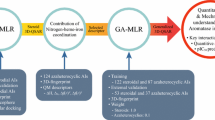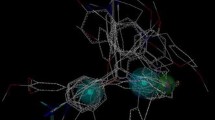Abstract
Aromatase, a rate-limiting enzyme catalyzing the conversion of androgen to estrogen, is overexpressed in human breast cancer tissue. Aromatase inhibitors (AIs) have been used for the treatment of estrogen-dependent breast cancer in post-menopausal women by blocking the biosynthesis of estrogen. The undesirable side effects in current AIs have called for continued pursuit for novel candidates with aromatase inhibitory properties. This study explores the chemical space of all known AIs as a function of their physicochemical properties by means of univariate (i.e., statistical and histogram analysis) and multivariate (i.e., decision tree and principal component analysis) approaches in order to understand the origins of aromatase inhibitory activity. Such a non-redundant set of AIs spans a total of 973 compounds encompassing both steroidal and non-steroidal inhibitors. Substructure analysis of the molecular fragments provided pertinent information on the structural features important for ligands providing high and low aromatase inhibition. Analyses were performed on data sets stratified according to their structural scaffolds (i.e., steroids and non-steroids) and bioactivities (i.e., actives and inactives). These analyses have uncover a set of rules characteristic to active and inactive AIs as well as revealing the constituents giving rise to potent aromatase inhibition.



Similar content being viewed by others
References
Jemal A, Bray F, Center MM, Ferlay J, Ward E, Forman D (2011) Global cancer statistics. CA Cancer J Clin 61:69–90. doi:10.3322/caac.20107
Miller WR (2003) Aromatase inhibitors: mechanism of action and role in the treatment of breast cancer. Semin Oncol 30:3–11
Jordan VC (2004) Selective estrogen receptor modulation: concept and consequences in cancer. Cancer Cell 5:207–213. doi:10.1016/S1535-6108(04)00059-5
Fisher B, Costantino JP, Redmond CK, Fisher ER, Wickerham DL, Cronin WM (1994) Endometrial cancer in tamoxifen-treated breast cancer patients: findings from the National Surgical Adjuvant Breast and Bowel Project (NSABP) B-14. J Natl Cancer Inst 86:527–537. doi:10.1093/jnci/86.7.527
Ghosh D, Griswold J, Erman M, Pangborn W (2009) Structural basis for androgen specificity and oestrogen synthesis in human aromatase. Nature 457:219–223. doi:10.1038/nature07614
Ghosh D, Lo J, Morton D, Valette D, Xi J, Griswold J, Hubbell S, Egbuta C, Jiang W, An J, Davies HM (2012) Novel aromatase inhibitors by structure-guided design. J Med Chem 55:8464–8476. doi:10.1021/jm300930n
Simpson ER, Clyne C, Rubin G, Boon WC, Robertson K, Britt K, Speed C, Jones M (2002) Aromatase—a brief overview. Annu Rev Physiol 64:93–127. doi:10.1146/annurev.physiol.64.081601.142703
Burstein HJ, Prestrud AA, Seidenfeld J, Anderson H, Buchholz TA, Davidson NE, Gelmon KE, Giordano SH, Hudis CA, Malin J, Mamounas EP, Rowden D, Solky AJ, Sowers MR, Stearns V, Winer EP, Somerfield MR, Griggs JJ (2010) American Society of Clinical Oncology clinical practice guideline: update on adjuvant endocrine therapy for women with hormone receptor-positive breast cancer. J Clin Oncol 28:3784–3796. doi:10.1200/jco.2009.26.3756
Ponzone R, Mininanni P, Cassina E, Pastorino F, Sismondi P (2008) Aromatase inhibitors for breast cancer: different structures, same effects? Endocr Relat Cancer 15:27–36. doi:10.1677/erc-07-0249
Lønning PE (2004) Aromatase inhibitors in breast cancer. Endocr Relat Cancer 11:179–189
Lipinski CA, Lombardo F, Dominy BW, Feeney PJ (2001) Experimental and computational approaches to estimate solubility and permeability in drug discovery and development settings. Adv Drug Deliv Rev 46:3–26
VIDA (2013) Version 4.2.1. OpenEye Scientific Software, Santa Fe, NM
Babel (2013) Version 3.3. OpenEye Scientific Software, Santa Fe, NM
Isarankura-Na-Ayudhya C, Nantasenamat C, Buraparuangsang P, Piacham T, Ye L, Bülow L, Prachayasittikul V (2008) Computational insights on sulfonamide imprinted polymers. Molecules 13:3077–3091. doi:10.3390/molecules13123077
Suksrichavalit T, Prachayasittikul S, Piacham T, Isarankura-Na-Ayudhya C, Nantasenamat C, Prachayasittikul V (2008) Copper complexes of nicotinic–aromatic carboxylic acids as superoxide dismutase mimetics. Molecules 13:3040–3056. doi:10.3390/molecules13123040
Suksrichavalit T, Prachayasittikul S, Nantasenamat C, Isarankura-Na-Ayudhya C, Prachayasittikul V (2009) Copper complexes of pyridine derivatives with superoxide scavenging and antimicrobial activities. Eur J Med Chem 44:3259–3265. doi:10.1016/j.ejmech.2009.03.033
Prachayasittikul V, Isarankura-Na-Ayudhya C, Tantimongcolwat T, Nantasenamat C, Galla HJ (2007) EDTA-induced membrane fluidization and destabilization: biophysical studies on artificial lipid membranes. Acta Biochim Biophys Sin 39:901–913. doi:10.1111/j.1745-7270.2007.00350.x
Prachayasittikul S, Wongsawatkul O, Worachartcheewan A, Nantasenamat C, Ruchirawat S, Prachayasittikul V (2010) Elucidating the structure–activity relationships of the vasorelaxation and antioxidation properties of thionicotinic acid derivatives. Molecules 15:198–214. doi:10.3390/molecules15010198
Nantasenamat C, Li H, Isarankura-Na-Ayudhya C, Prachayasittikul V (2012) Exploring the physicochemical properties of templates from molecular imprinting literature using interactive text mining approach. Chemometr Intell Lab Syst 116:128–136. doi:10.1016/j.chemolab.2012.05.006
Piacham T, Isarankura-Na-Ayudhya C, Nantasenamat C, Yainoy S, Ye L, Bülow L, Prachayasittikul V (2006) Metalloantibiotic Mn(II)–bacitracin complex mimicking manganese superoxide dismutase. Biochem Biophys Res Commun 341:925–930. doi:10.1016/j.bbrc.2006.01.045
Piacham T, Nantasenamat C, Suksrichavalit T, Puttipanyalears C, Pissawong T, Maneewas S, Isarankura-Na-Ayudhya C, Prachayasittikul V (2009) Synthesis and theoretical study of molecularly imprinted nanospheres for recognition of tocopherols. Molecules 14:2985–3002. doi:10.3390/molecules14082985
Mandi P, Nantasenamat C, Srungboonmee K, Isarankura-Na-Ayudhya C, Prachayasittikul V (2012) QSAR study of anti-prion activity of 2-aminothiazoles. EXCLI J 11:453–467
Nantasenamat C, Isarankura-Na-Ayudhya C, Naenna T, Prachayasittikul V (2008) Prediction of bond dissociation enthalpy of antioxidant phenols by support vector machine. J Mol Graph Model 27:188–196. doi:10.1016/j.jmgm.2008.04.005
Nantasenamat C, Piacham T, Tantimongcolwat T, Naenna T, Isarankura-Na-Ayudhya C, Prachayasittikul V (2008) QSAR model of the quorum-quenching N-acyl-homoserine lactone lactonase activity. J Biol Syst 16:279–293. doi:10.1142/S021833900800254X
Pingaew R, Tongraung P, Worachartcheewan A, Nantasenamat C, Prachayasittikul S, Ruchirawat S, Prachayasittikul V (2012) Cytotoxicity and QSAR study of (thio)ureas derived from phenylalkylamines and pyridylalkylamines. Med Chem Res. doi:10.1007/s00044-012-0402-6
Thippakorn C, Suksrichavalit T, Nantasenamat C, Tantimongcolwat T, Isarankura-Na-Ayudhya C, Naenna T, Prachayasittikul V (2009) Modeling the LPS neutralization activity of anti-endotoxins. Molecules 14:1869–1888. doi:10.3390/molecules14051869
Worachartcheewan A, Nantasenamat C, Isarankura-Na-Ayudhya C, Prachayasittikul S, Prachayasittikul V (2011) Predicting the free radical scavenging activity of curcumin derivatives. Chemometr Intell Lab Syst 109:207–216. doi:10.1016/j.chemolab.2011.09.010
Worachartcheewan A, Nantasenamat C, Isarankura-Na-Ayudhya C, Prachayasittikul V (2013) Predicting antimicrobial activities of benzimidazole derivatives. Med Chem Res. doi:10.1007/s00044-013-0539-y
Worachartcheewan A, Nantasenamat C, Naenna T, Isarankura-Na-Ayudhya C, Prachayasittikul V (2009) Modeling the activity of furin inhibitors using artificial neural network. Eur J Med Chem 44:1664–1673. doi:10.1016/j.ejmech.2008.09.028
Nantasenamat C, Isarankura-Na-Ayudhya C, Naenna T, Prachayasittikul V (2007) Quantitative structure–imprinting factor relationship of molecularly imprinted polymers. Biosens Bioelectron 22:3309–3317. doi:10.1016/j.bios.2007.01.017
Nantasenamat C, Isarankura-Na-Ayudhya C, Tansila N, Naenna T, Prachayasittikul V (2007) Prediction of GFP spectral properties using artificial neural network. J Comput Chem 28:1275–1289. doi:10.1002/jcc.20656
Nantasenamat C, Naenna T, Prachayasittikul V (2005) Quantitative prediction of imprinting factor of molecularly imprinted polymers by artificial neural network. J Comput Aided Mol Des 19:509–524. doi:10.1016/S1535-6108(04)00059-5
Nantasenamat C, Srungboonmee K, Jamsak S, Tansila N, Isarankura-Na-Ayudhya C, Prachayasittikul V (2013) Quantitative structure–property relationship study of spectral properties of green fluorescent protein with support vector machine. Chemometr Intell Lab Syst 120:42–52. doi:10.1016/j.chemolab.2012.11.003
Worachartcheewan A, Dansethakul P, Nantasenamat C, Pidetcha P, Prachayasittikul V (2012) Determining the optimal cutoff points for waist circumference and body mass index for identification of metabolic abnormalities and metabolic syndrome in urban Thai population. Diabetes Res Clin Pract 98:e16–e21. doi:10.1016/j.diabres.2012.09.018
Frisch MJ, Trucks GW, Schlegel HB, Scuseria GE, Robb MA, Cheeseman JR, Scalmani G, Barone V, Mennucci B, Petersson GA, Nakatsuji H, Caricato M, Li X, Hratchian HP, Izmaylov AF, Bloino J, Zheng G, Sonnenberg JL, Hada M, Ehara M, Toyota K, Fukuda R, Hasegawa J, Ishida M, Nakajima T, Honda Y, Kitao O, Nakai H, Vreven T, Montgomery JA, Peralta JE, Ogliaro F, Bearpark M, Heyd JJ, Brothers E, Kudin KN, Staroverov VN, Kobayashi R, Normand J, Raghavachari K, Rendell A, Burant JC, Iyengar SS, Tomasi J, Cossi M, Rega N, Millam JM, Klene M, Knox JE, Cross JB, Bakken V, Adamo C, Jaramillo J, Gomperts R, Stratmann RE, Yazyev O, Austin AJ, Cammi R, Pomelli C, Ochterski JW, Martin RL, Morokuma K, Zakrzewski VG, Voth GA, Salvador P, Dannenberg JJ, Dapprich S, Daniels AD, Farkas Ö, Foresman JB, Ortiz JV, Cioslowski J, Fox DJ (2009) Gaussian 09, Revision A.02. Gaussian, Inc., Wallingford
DRAGON for Windows (Software for Molecular Descriptor Calculations) (2007) Version 5.5. Talete srl, Milano, Italy
The Unscrambler (2005) Version 9.5. Camo Process AS, Oslo, Norway
Witten IH, Frank E, Hall MA (2011) Data mining: practical machine learning tools and techniques. Morgan Kaufmann, Burlington
Worachartcheewan A, Nantasenamat C, Isarankura-Na-Ayudhya C, Pidetcha P, Prachayasittikul V (2010) Identification of metabolic syndrome using decision tree analysis. Diabetes Res Clin Pract 90:e15–18. doi:10.1016/j.diabres.2010.06.009
JChem (2012) Version 5.10. ChemAxon Ltd., Hungary
Li SF, He HD, Parthiban LJ, Yin HQ, Serajuddin ATM (2005) IV–IVC considerations in the development of immediate-release oral dosage form. J Pharm Sci 21. doi:10.1002/jps.20378
Strazielle N, Ghersi-Egea JF (2005) Factors affecting deivery of antiviral drugs to the brain. Rev Med Virol 15:105–133. doi:10.1002/rmv.454
Bulat FA, Chamorro E, Fuentalba P, Toro-Labbe A (2004) Condensation of frontier molecular orbital fukui functions. J Phys Chem A 108:342–349. doi:10.1021/jp036416r
Aihara J (1999) Reduced HOMO–LUMO gap as an index of kinetic stability for polycyclic aromatic hydrocarbons. J Phys Chem A 103:7487–7495. doi:10.1021/jp990092i
Esbensen KH, Guyot D, Westad F, Houmoller LP (2004) Multivariate data analysis—in practice. CAMO Process AS, Esbjerg
Wold S, Esbensen K, Geladi P (1987) Principal component analysis. Chemometr Intell Lab Syst 2:37–52. doi:10.1016/0169-7439(87)80084-9
Suenderhauf C, Hammann F, Huwyler J (2012) Computational prediction of blood–brain barrier permeability using decision tree induction. Molecules 17:10429–10445. doi:10.3390/molecules170910429
Yang XG, Chen D, Wang M, Xue Y, Chen YZ (2009) Prediction of antibacterial compounds by machine learning approaches. J Comput Chem 30:1202–1211. doi:10.1002/jcc.21148
DeSimone RW, Currie KS, Mitchell SA, Darrow JW, Pippin DA (2007) Privileged structures: applications in drug discovery. Comb Chem High Throughput Screen 7:473–493. doi:10.2174/1386207043328544
McInnes C (2007) Virtual screening strategies in drug discovery. Curr Opin Chem Biol 11:494–5025. doi:10.1016/j.cbpa.2007.08.033
Acknowledgments
The Goal-Oriented Research Grant of Mahidol University to C.N. is gratefully acknowledged for financial support of this research. H.L., P.M., and T.M. are grateful for research assistantship supported by Grants from Mahidol University. This project was also supported in part by the Office of the Higher Education Commission and Mahidol University under the National Research Universities Initiative.
Author information
Authors and Affiliations
Corresponding author
Electronic supplementary material
Below is the link to the electronic supplementary material.
Rights and permissions
About this article
Cite this article
Nantasenamat, C., Li, H., Mandi, P. et al. Exploring the chemical space of aromatase inhibitors. Mol Divers 17, 661–677 (2013). https://doi.org/10.1007/s11030-013-9462-x
Received:
Accepted:
Published:
Issue Date:
DOI: https://doi.org/10.1007/s11030-013-9462-x




